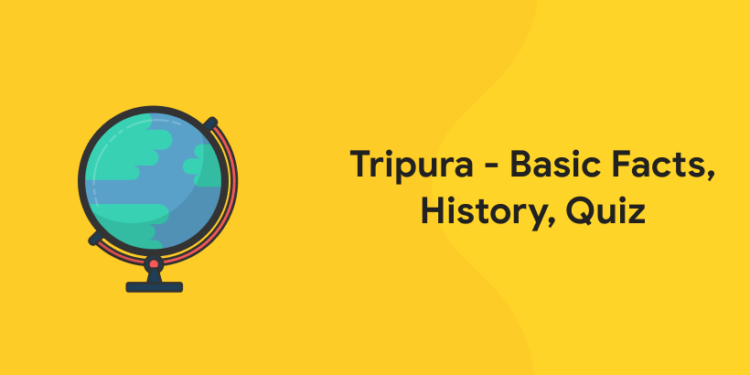Table of Contents
Tripura is the 26th largest state and the 3rd smallest state in India which is the hilly state located in the northeastern region of India and that is connected to the rest of states via NH8. Tripura has a total size of 10,491.69 km2 (4,050.86 sq miles) and the state is bordered by Bangladesh to the north, south, west, and the Indian states of Assam and Mizoram to the east also home to a diverse mix of tribal cultures and religious groups In 2011 the state had 3,671,032 residents, constituting 0.3% of the country’s population.
Tripura: History
The State of Tripura has a long history. Tripura was accorded the status of a ‘C’ category state on January 26, 1950 and it was recognized as a Union Territory on November 1, 1956. It gained statehood on January 21, 1972, as per the North-East Reorganization Act, 1971 by the sustained efforts and struggle of the people of Tripura. The capital is Agartala, near the Bangladesh border in the northwestern part of the state. Agartala is the commercial centre of the region. It is home to the Ujjayanta Palace, the meeting place of the Legislative Assembly of Tripura.
Overview
| Key Elements | Details |
| Area | 10,491.69 km2 |
| Capital | Agartala |
| No. of Districts | 8 |
| Official languages | Bengali, Kokborok, Hindi |
| Chief Minister | Biplab Kumar Deb |
| Deputy Chief Minister | Jishnu Deb Barman |
| Governor | Satyadev Narayan Arya |
The area of modern Tripura ruled for several centuries by the Manikya dynasty was part of an independent princely state under the protectorate of the British Empire. The independent Tripuri Kingdom (also known as Hill Tippera) joined the newly independent India in 1949. Tripura has the highest number of primate species found in any Indian state. Due to its geographical isolation, economic progress in the state is hindered. Poverty and unemployment continue to plague Tripura, which has a limited infrastructure. Most residents are involved in agriculture and allied activities, although the service sector is the largest contributor to the state’s gross domestic product.
Agriculture is the principal occupation; rice, jute, tea, and cotton are the major crops. Industries include cloth weaving; rice and flour milling; fruit canning; utensil making; production of cane, bamboo, and leather goods; and soap manufacture. Tree farming and other horticulture as well as fish farming are practiced. Agartala is the principal city; also important are the towns of Belonia and Khowai.
The physiography is characterised by hill ranges, valleys and plains. The state has five anticlinal ranges of hills running north to south, from Boromura in the west, through Atharamura, Longtharai and Shakhan, to the Jampui Hills in the east. The intervening synclines are the Agartala–Udaipur, Khowai–Teliamura, Kamalpur–Ambasa, Kailasahar–Manu and Dharmanagar–Kanchanpur valleys.At an altitude of 939 m (3,081 ft), Betling Shib in the Jampui range is the state’s highest point. The small isolated hillocks interspersed throughout the state are known as tillas, and the narrow fertile alluvial valleys, mostly present in the west, are called lungas. A number of rivers originate in the hills of Tripura and flow into Bangladesh. The Khowai, Dhalai, Manu, Juri and Longai flow towards the north; the Gumti to the west; and the Muhuri and Feni to the south west.
Attempt Free GK Mock Test! Download Entri App!
Tripura: Basic Facts
1: Who was the first woman President of India?
- The oldest known name of Tripura is Kirat Desh.
- It became Union territory on 1 Nov 1957 and became a full fledged state on 21 Jan 1972. Two more states came to existence on this date. They were – Meghalaya and Manipur.
- Before partition of East Pakistan (Present Bangladesh) the distance between Kolkata and Agartala was less than 350 Km which increased to 1700 Km after partition as the vehicles had to cover a long route.
- Since 1990 there are several incidents of terrorist activities by militant outfits such as ATTF (All Tripura Tiger Force) and NLFT (National Liberation Front of Tripura).
- Bir Chandra Manikya was the king of Tripura from 1862 to 1896 and gained popularity due to his various administrative reforms.
- Tripura is bounded by 2 states – Mizoram in the east and Assam in northeast. It is surrounded by Bangladesh from north, west and south.
- Length of the international border of Tripura is 856 Km. Tripura has the 5th longest international border length among Indian states lying on borders.
- This is the third smallest state of the Indian union.
- Till 2012 there were only 4 districts, but after 21 Jan 2012 total 8 districts were created.
- Dhalai district is the largest district in terms of area. Sipahijala district is largest by population. West Tripura district has maximum population density.
Free UPSKILLING Courses!
Take your first step toward mastering in-demand skills, acing interviews, and securing top-tier jobs with Entri's free upskilling courses.
Start Learning!Tripura GK Quiz
Q.1. Tripura attained full statehood on?
[A] 1975
[B] 1972
[C] 1981
[D] 1970
Answer: [B] 1972
Q.2. Total number of districts in Tripura?
[A] 6
[B] 11
[C] 8
[D] 5
Answer: [C] 8
Q.3. Who was the first chief minister of Tripura ?
[A] Sachindra Lal Singh
[B] Prafulla Kumar Das
[C] Sen Gupta
[D] Samir Ranjan Barman
Answer: [A] Sachindra Lal Gupta
Q.4. Which India states share a border with Tripura?
[A] Assam and West Bengal[B] Mizoram and Assam
[C] Haryana and Mizoram
[D] None of these
Answer: [B] Mizoram and Assam
Q.5. Which Dynasty ruled Tripura for many centuries ?
[A] Chola Dynasty
[B] Khalji Dynasty
[C] Manikya Dynasty
[D] All the above
Answer. [C] Manikya Dynasty
Q.6. Which one is the largest district by area wise in Tripura?
[A] South Tripura
[B] Dhalai
[C] Gomati
[D] West Tripura
Answer: [B] Dhalai
Q.7. Which is the official language of Telangana?
[A] Bengali
[B] Hindi
[C] Kokborok
[D] All of the above
Answer: [D] All of the above
Q.8. Capital of Tripura is ________.
[A] Agartala
[B] West Bengal
[C] Hyderabad
[D] Warangal
Answer: [A] Agartala
Q.9. Which Country shares its border with Tripura?
[A] China
[B] Bangladesh
[C] Afghanistan
[D] Brazil
Answer: [B] Bangladesh
Q.10. When did the Independent Tripuri Kingdom join the newly Independent India ?
[A]15 October 1949
[B] 20 September 1949
[C] 2 October 1949
[D] 25 October 1949
Answer: [A] 15 October 1949
Q.11. How many sub-divisions are there in Tripura?
[A] 22
[B] 23
[C] 13
[D] 27
Answer: [B] 23
Q.12. Which district in Tripura has only one Municipal Council?
[A] North Tripura
[B] West Tripura
[C] South Tripura
[D] Dhalai
Answer: [A] North Tripura
Q.13. Which is the Old Capital of Tripura?
[A] Khayerpur
[B] Agartala
[C] Udaipur
[D] Ambassa
Answer: [C] Udaipur
Prepare for various Government exams! Download Entri App!













